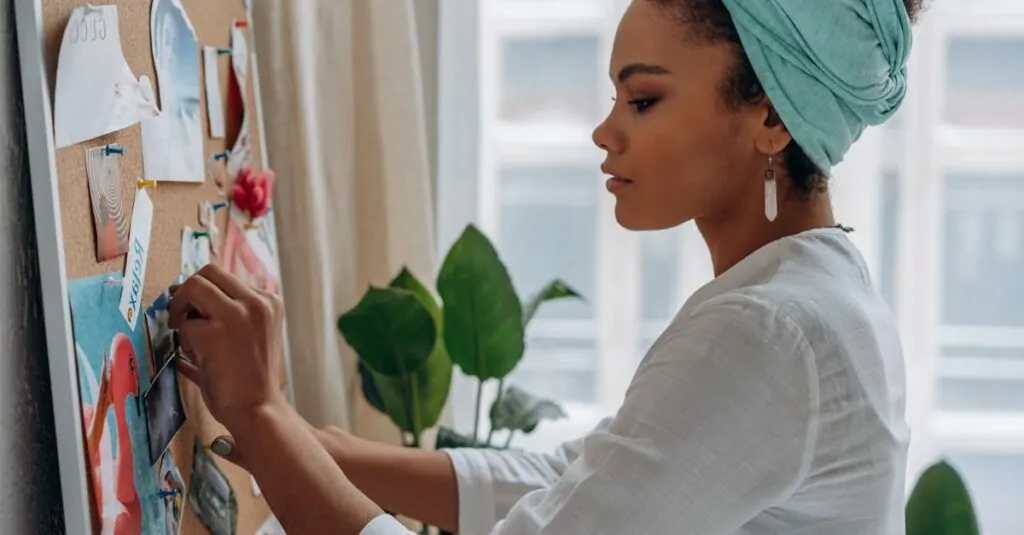Table of Contents
ToggleTransforming a house into a home is like giving your space a personality makeover. With the right interior design ideas, even the drabbest rooms can become vibrant reflections of who you are. Who wouldn’t want a living room that practically screams, “Welcome, friends! Stay awhile!”?
Popular Interior Design Styles
Various interior design styles appeal to homeowners seeking to create personalized spaces. Each style offers unique characteristics and enhances a home’s aesthetic.
Modern Design
Modern design emphasizes clean lines and minimal ornamentation. This style often employs neutral color palettes, complemented by bold accents. Furniture tends to be functional, featuring simple shapes and open spaces. Natural materials like wood and stone play an essential role in creating warmth. Lighting fixtures in modern design provide both ambiance and artistic flair, enhancing the overall feel of a room.
Traditional Design
Traditional design reflects timeless elegance and classic beauty. This style showcases rich colors and textures, often incorporating darker woods and detailed moldings. Furniture in traditional settings features intricate designs and luxurious fabrics, promoting comfort and sophistication. Patterns, such as florals and plaids, create visual interest. Accessories like chandeliers and vintage art pieces contribute to a polished, cohesive look.
Minimalist Design
Minimalist design strips away excess, focusing on essential elements. This style celebrates simplicity and functionality while showcasing open spaces. Neutral colors dominate, with occasional pops of color through select decor items. Furniture often highlights geometric shapes and lacks unnecessary decoration. Elements like natural light are prioritized, enhancing the tranquil atmosphere created by minimalist design.
Color Schemes and Palettes
Color schemes and palettes significantly impact a home’s interior design. Selecting the right colors can enhance mood and space perception, creating a vibrant and inviting atmosphere.
Warm Colors
Warm colors include reds, oranges, and yellows. These shades create a cozy and energetic environment. Living rooms often benefit from warm tones, fostering feelings of happiness and intimacy. Accent walls painted in deep reds or golden yellows add character and depth. Additionally, combining warm colors with natural light intensifies their impact, making spaces feel welcoming.
Cool Colors
Cool colors encompass blues, greens, and purples. These hues promote tranquility and relaxation, making them ideal for bedrooms and bathrooms. Soft blues can evoke a serene vibe, while muted greens connect spaces with nature. Incorporating cool colors in textiles, such as curtains or cushions, creates a balanced ambiance. Light purple accents can also add a touch of elegance without overwhelming a room’s decor.
Neutral Tones
Neutral tones are versatile, including shades of beige, gray, and white. These colors create a calm backdrop that complements various decor styles. They provide flexibility by allowing homeowners to easily incorporate bolder colors through furnishings and accessories. Using neutrals can unify different spaces, promoting a cohesive look throughout a home. A well-placed neutral palette invites creativity while maintaining a sophisticated aesthetic.
Furniture Arrangement Tips
Furniture arrangement plays a critical role in maximizing space and functionality within a home. Thoughtful layout can enhance both flow and comfort.
Open Concept Spaces
Open concept spaces benefit from well-defined areas. Establish zones based on function by separating the living area from the dining and kitchen sections. Using rugs can visually delineate each zone while adding warmth. Position furniture away from walls to create an inviting ambiance. Include a focal point, like a fireplace or art piece, to unify the space. Balance larger furniture pieces with smaller items to maintain visual flow. Ensure pathways remain unobstructed, allowing easy movement throughout the home.
Creating Cozy Corners
Cozy corners provide intimate spaces for relaxation. Arrange seating to promote conversation, using soft cushions and throws for added comfort. Incorporate a small table within reach for convenience. Place plants or decorative items to enhance aesthetics and create a welcoming atmosphere. Lighting matters too; use floor lamps or table lamps to produce a warm glow. Select placement based on natural light sources to optimize brightness during the day. Each corner should invite individuals to unwind and enjoy moments of tranquility.
Accessorizing Your Home
Accessorizing enhances a home’s character and warmth. Thoughtfully chosen items can create a cohesive style that reflects personal taste and lifestyle.
Decorative Elements
Art pieces capture attention and express individuality. Wall art, sculptures, and framed photographs enrich spaces with color and emotion. Incorporating plants adds life and texture, creating a fresh ambiance. Decorative pillows and throws soften furniture while introducing patterns. Area rugs can define spaces and add comfort underfoot. Mirrors effectively expand rooms by reflecting light and creating visual interest. Each decorative element contributes to a home that feels both inviting and stylish.
Functional Accessories
Functional accessories ensure a space is practical and efficient. Bins and baskets can organize items while complementing decor. Stylish lighting fixtures, like table and floor lamps, provide ample illumination and set an atmosphere. Multi-purpose furniture, such as ottomans with storage, maximizes use in limited spaces. Throw blankets serve dual purposes by offering warmth and adding aesthetic value. Shelving units showcase books and decorative items, enhancing organization while being visually appealing. Every functional accessory plays a vital role in maintaining both style and practicality.
Sustainable Interior Design Ideas
Sustainable interior design focuses on creating environmentally friendly and energy-efficient spaces. This approach not only enhances aesthetics but also reduces the overall environmental impact.
Eco-Friendly Materials
Using eco-friendly materials significantly impacts sustainability. Bamboo, for instance, offers durability and renewability. Recycled wood adds character while minimizing waste. Low-VOC paints improve air quality and reduce harmful emissions. Cork flooring provides comfort and sustainability due to its natural properties. Additionally, natural fabrics like organic cotton and linen promote healthier indoor environments. Each of these options supports eco-conscious living while contributing to visually appealing interiors.
Energy-Efficient Solutions
Implementing energy-efficient solutions is essential for modern homes. LED lighting consumes less energy, lasts longer, and enhances ambiance. Programmable thermostats optimize heating and cooling, leading to reduced energy bills. Energy-efficient appliances also deliver performance while consuming less power. Incorporating large windows maximizes natural light, reducing reliance on artificial lighting. Using insulated curtains helps regulate indoor temperatures and minimize energy loss. Every initiative contributes to a sustainable and comfortable living environment.
Transforming a house into a home is an exciting journey filled with endless possibilities. By embracing various design styles and thoughtful color schemes, homeowners can create inviting spaces that truly reflect their personalities.
Careful furniture arrangement and the addition of carefully selected accessories not only enhance aesthetics but also improve functionality. Sustainable design choices further elevate the home’s character while promoting eco-conscious living.
Ultimately, the right interior design ideas can turn any space into a vibrant sanctuary that welcomes both residents and guests alike. With a little creativity and intention, anyone can achieve a harmonious and stylish home environment.







